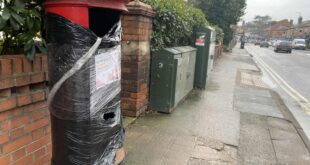A few weeks ago, I received a text from a close friend in Scotland with whom I had not spoken for three months. “Ednburgh is missng u xxxxxxx” was written below a blurry picture of the author squatting on a balcony. It was dark, and he clasped a pint of beer in his hand. Atop his head sat a traffic cone, mildly askew.
This message felt very distant from the 2 p.m. Valley Life Sciences lecture where I received it. However, in the U.K., it was after 10 p.m.; I daresay an acceptable hour of the evening to message a close friend with absent ‘i’s and ample ‘x’s.
Any Brit communicating with home from the Pacific Coast, such as myself, will tell you that the time difference is hard. While I head to my first class, my friends are heading to the pub. As I tuck myself into bed, my friends battle ripe hangovers. A large part of friendship relies on shared temporality: waking up with a headache together.
However, despite the time difference and the three-month silence, I would still consider Mr. Traffic Cone one of my closest friends. His message made me smile.
Another (more sober) friend who, contrastingly, I text almost every day asked me, “how have you been staying in touch with close people back home?”
I went to answer: “The close ones get letters.” The other day, I gladly suffered the $1.50 international postage fee to send a letter to one my dearest Brits: my grandmother. Being close, we occasionally exchange a page or two of handwritten life updates.
Handwriting feels personally intimate, and the time taken to write and post a letter is a clear demonstration of the receiver’s value. This, I feel, makes post a relevant mode of communication for close friends in the modern age.
But then I realized that the people with whom I exchange letters to are not necessarily always the closest. A Tinder match from when I was last in London whom I have barely spoken to recently asked for my address. “Sorry, what?” I replied.
“I want to send a postcard to California.”
We had several mutual friends, and I was intrigued. A week later, a red London bus card with a Royal Mail stamp in the top right-hand corner slipped through my door.
A dangerous overfamiliarity with strangers from the internet means that my own experiences may be slightly unique. However, apparently for me, postal communication is not a definite indicator of closeness.
So, can we gauge closeness, instead, by frequency of social media communication? It is no secret that most conversation nowadays is immediate. Regardless of how ‘slow of a replier’ your friend is, your message is available in their inbox the moment you press send, provided that you are disconnected from campus Wi-Fi.
I often wonder if the past’s lack of instantaneous communication resulted in people feeling geographic distance more intensely. But I don’t think it did. The constant exposure to home on my phone’s screen — contrasted against where I physically am — illuminates the distance.
Mr. Traffic Cone broke our three-month radio silence with the notorious image taken outside of our favorite Edinburgh nightclub. This reminded me of how in the United States, I am still not of clubbing age.
My family texted me a video from an orchestral recital they attended at Kensington’s Royal Albert Hall. The rendition of “Land of Hope and Glory” against a jingoistic Union Flag backdrop was aggressively at odds with the American flag under which I walked on my way to class.
I was snapchatted an image of friends I have known for 10 years in Oxford crammed around a dining table. Here, dinner is shared with no one I have known for longer than four months.
My mother’s WhatsApp messages of the gleaming river Thames as she commutes into the city via Uber boat are a sore reminder of a city with efficient public transport.
But along with receiving no letters, Mr. Traffic Cone and I had additionally passed three months without messaging in such a painfully instantaneous way until the peculiar Valley Life Sciences incident. So why, despite the silence, would I still maintain that he is one of my closest friends?
My (sober) friend asked, “Has seeing who you’ve stayed in touch with sorted the wheat from the chaff?” This linguistic Britishism, too, drove a homesick pang through my stomach. And before moving, I’d have agreed with her.
Like a sculptor at a marble block, I’d expected the chips of those less close to gather at my feet, revealing a statue of “true” friends at the block’s core. But this really isn’t the case.
Instead, at the heart of the block is silence. Comfortable silence.
I have realized that a good relationship is where the requirement to force contact is not felt. Frequency and mode of communication are not indicators of the quality of a friendship. Instead, good friends — such as Mr. Traffic Cone and I — have confidence in the quiet.
So, Mr. Traffic Cone, as much as I enjoyed your image, I’ve enjoyed our radio silence too; it’s a sign of our friendship. And I know that when I eventually see you again, the hush between us right now will only make our conversations louder. And maybe, just maybe, I’ll be wearing a traffic cone then too, mildly askew.
Stanley Stott-Hall writes about finding his Berkeley bearings as a Brit. Contact the opinion desk at [email protected] or follow us on Twitter @dailycalopinion.



